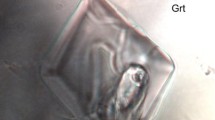Abstract.
A metagranodiorite from the ultra-high pressure (UHP) Brossasco–Isasca Unit (BIU) of the southern Dora Maira Massif, Western Alps, contains relicts of jadeite developed as a pseudomorph after igneous plagioclase during the Alpine UHP metamorphism. The jadeite is characterised by a slight but significant shortage of total cations. On average, for 6 oxygens, the sum of M2 (Na + Ca) cations is 0.93. Careful algebraic calculations on the jadeite end members indicate that Ca and Al combine to form the calcium-Eskola (CaEs) molecule (0.08–0.17) and minor calcium-Tschermack (CaTs) molecule (≤0.03). This is the first report of jadeite with significant amounts of CaEs component from a natural UHP metagranitoid rock. The finding of CaEs molecule in the metagranodiorite is further evidence that the rock experienced UHP metamorphism during the Alpine metamorphism.
Similar content being viewed by others
Author information
Authors and Affiliations
Additional information
Electronic Publication
Rights and permissions
About this article
Cite this article
Bruno, M., Compagnoni, R., Hirajima, T. et al. Jadeite with the Ca-Eskola molecule from an ultra-high pressure metagranodiorite, Dora-Maira Massif, Western Alps. Contrib Mineral Petrol 142, 515–519 (2002). https://doi.org/10.1007/s004100100307
Received:
Accepted:
Issue Date:
DOI: https://doi.org/10.1007/s004100100307




